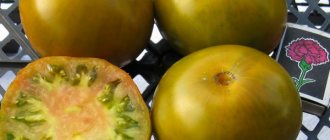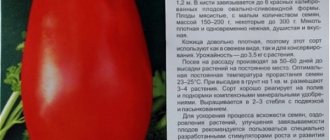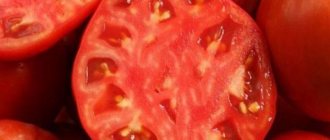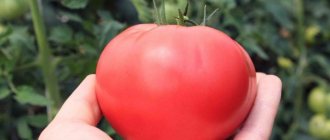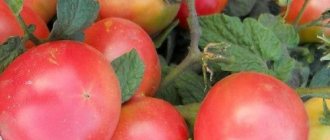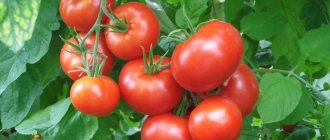Agronomist expert Expert in planting your garden bed Suggest an article
- Join us
Join us and follow the news on social networks
Home › Planting and growing › Vegetable garden › Solanaceae › Tomato
478
Experienced gardeners love to experiment with exotic varieties. Modern selection pampers its consumers with tomatoes of unusual colors. There are yellow, black, green, orange, brown and multi-colored tomatoes on sale.
Among the most unusual varieties is the Alice's Dream tomato. The bicolor of its fruits is unlikely to leave anyone indifferent. What are the features of this tomato variety - read on.
- General description of the variety Features of the tomato Alice's Dream
- Main characteristics
- Preparation of planting material
- Planting seedlings in the ground
General description of the variety
Alice's Dream is a variety obtained by Polish breeders . It was obtained by cross-pollination of the Blue Gold and Amethyst Jewel varieties. First grown on the plantation of a famous Polish agronomist in 2015. The original name of the variety is Alice's Dream. Therefore, some producers translate it as Alice's Dream.
Alice's dream is a new variety. It is not included in the Russian register . Large companies in our country do not produce it yet. This tomato is not easy to get, so it is considered a collector's item.
Features of the Alice's Dream tomato
The main feature of the Dream Alice tomatoes is the unusual color of the fruit . The main color of their skin is orange-yellow, it has red stripes and purple or brown spots. Look how the berries of these tomatoes look in the photo.
The taste of the fruit is also unusual. It is sweet, without pronounced sourness. Gardeners who have already tried Alice's Dream say that such tomatoes have a pleasant citrus aftertaste.
Interesting. The fruits contain a lot of anthocyanin, which reduces inflammatory reactions in the intestines and has a beneficial effect on digestive function.
Alice's Dream is considered a salad variety . These tomatoes are consumed mainly fresh. They are not suitable for preservation and processing into tomato juices.
Gardeners claim that the variety is highly resistant to tomato diseases . Since the variety is still young, this information has not yet been confirmed.
Alice's Dream tomatoes are not easy to care for . They do not like the cold and are demanding when it comes to watering. Those who can satisfy all the requirements of this variety will be rewarded with exotic fruits with an unusual taste and color.
Main characteristics
The description of the Alice's Dream variety will impress even experienced gardeners. This unusual tomato has good performance.
Characteristics of Alice's Dream:
| Parameter | Indicators |
| Bush type | Indeterminate. It grows in height up to 1.7-2 m. It has thick stems with an average amount of foliage. The leaves are simple light green. Tomatoes are formed on clusters of 8-10 pieces. On average, one bush produces 4 brushes per bush. |
| Growing method | Heat-loving. They are grown in greenhouses and greenhouses. In the southern regions, cultivation in open ground is possible. |
| Productivity | High. One plant produces up to 5 kg of tomatoes per season. Per sq. m plant no more than 4 plants. |
| Fruit | Average. The average weight of one tomato reaches 180-250 g. There are specimens weighing up to 400 g. The outside of the tomatoes is dark yellow, covered with red stripes. There are brown or purple spots at the base. Orange inside, pink in the center. There may be brown spots in the pulp, but there are no green or white areas near the base. They have a lot of pulp. Juicy, but not watery. The taste is sweet, without acid. Inside there are a large number of small chambers, some with seeds, some empty. All chambers are filled with a jelly-like liquid. |
| Transportability | Low. Tomatoes are covered with thin skin. They don't last long. |
| Ripening time | Mid-season variety. Many gardeners classify it as an early ripening plant. In hot climates, the first harvest is harvested in late June or early July. |
| Disease resistance | Is immune to major tomato diseases |
Note! According to reviews from gardeners who grow Alice's Dream tomato, the variety is resistant to major tomato diseases. This information has not yet been confirmed by practice, since the variety is young and not included in the register.
Varieties and hybrids of tomatoes
According to the structure of the bushes, tomatoes are divided into:
- non-standard;
- standard;
- potato-shaped.
Non-standard ones are distinguished by thinner stems that lie down during the fruiting period, as well as large, slightly corrugated leaves.
Standard tomatoes are distinguished by compact bushes with fairly thick stems, strongly corrugated leaves, medium in size, with short petioles.
Potato-shaped (large-leaved) tomatoes are quite rare, and they are called so because of the leaves, which are shaped like potato leaves.
Hybrid tomatoes are virtually guaranteed to be resistant to diseases and bad weather conditions, which is something that non-hybrid varieties suffer from. Greenhouses and greenhouses are valued for storing heat, but in them tomatoes can suffer from too high temperatures and sudden temperature changes. In recent years, world selection has been aimed at producing “heat-resistant” hybrids with a reliable guarantee of ovary production.
Hybrids are especially helpful in a greenhouse or a small garden plot where there are no real opportunities for crop rotation and diseases are prevalent. Selection successes demonstrate confident resistance to various types of infections - viral (especially the most dangerous tobacco mosaic virus), fungal, bacterial. In addition, the hybrids have uniform fruits and consistently high yields.
Tomato Incas F1
One of the best hybrids for canning whole fruits without skin. Popular early high-yielding bush hybrid. The plant is medium-sized, compact.
Tomato from the Dutch company Numens, zoned in Russia; entered into the state register in 2000. Mid-early hybrid (105 days) of meter-high vegetables, determinate. Very high resistance to fungal diseases has been recorded. The fruits are 80-100 g, dense, bright red, pepper-shaped, fleshy, uniform, tolerate sunburn well, are very easy to ripen, transported over long distances without loss of quality.
Tomato Torquay F1
Dutch hybrid from Bejo Zaden; in the Russian register since 2007. Mid-season tomato (119-123 days from germination to ripening), bush type - determinate, maximum height 100 cm. Forms abundant multiple clusters with fruits weighing 60-140 g. Dense tomatoes withstand long-term transportation, excellent in pickling and pickling matters.
Tomato Mariana F1
The tomato was created in the French branch of the Japanese company Sakata (the image of the woman Mariana is a symbol of the French Republic). The breeders of this agricultural company are often suspected of producing GMOs, but so far without real evidence. Mariana is a mid-early determinate hybrid. The fruits are similar in shape to Incas - also elongated-oval, perfectly smooth, super dense.
Tomato Bagheera F1
Hybrid from the leading French seed company Cloz. Included in the Russian seed register in 2007.
Early high-yielding hybrids are a real boon for the garden. They are cold-resistant, do not need pinching or tying up, and practically do not get sick. The ripening period is marked as medium-early; determinate bush. The fruit is round, flattened on top, ribbed, weight ranges from 80-220 g. The hybrid is resistant to soil drought and nematode, more suitable for regions located in the south. Does not suffer from fusarium and verticillium wilt.
Tomato F1 Semko 2005
The tomato is suitable for open ground and under film shelters (greenhouses). Determinate, medium-sized, compact. Resistant to soil salinity, drought, high temperatures, grows well in open ground in both southern and northern regions. Vegetables practically do not suffer from viral and fungal diseases, even late blight.
Tomato F1 Semko 2010
Included in the state register in 2010. Ultra-early ripening determinate hybrid - 85-88 days pass from the sprouting of green vegetables to the coloring of fruits. The first brush is formed immediately after the sixth leaf grows. The fruits are incredibly dense for such an early tomato, and are by no means small - 130 g. The shape is round hearts with a beautiful pointed tip.
In open ground, we usually plant thickly - 5-6 bushes per square. The best harvest from such an area is at least a bucket. The hybrid is highly resistant to bacteria, fungi and viruses. Does not crack and does not suffer from blossom end rot. Successfully withstands high temperatures and dry soil.
The newest indeterminate hybrid (on the register since 2015) - tested by us, everything is fine - created taking into account all possible greenhouse disasters. Firstly, it sets well even in the heat, as well as during temperature changes. Secondly, it is tolerant of problematic soil substrates. Thirdly, it shows high resistance to viral, fungal and bacterial infections.
The yield of vegetables varies between 20-30 kg/1 square meter. Mid-early hybrid (100 days from green shoots). The clusters begin to form after 7-9 leaves, each bears 5-6 tomatoes in the shape of rounded hearts, smooth, beautiful, attractive orange color. The weight of the “heart” is 160-190 g. The pulp contains a high percentage of dry matter, sugars, and carotenoids.
Bushes of unlimited growth, with dense foliage. Mandatory shaping is required, including a garter. Hybrid of medium early or medium ripening period (112-118 days). Clusters of 6-8 tomatoes weighing 130-150 g. The fruits are plum-shaped, slightly tapering downwards. They are deep red in color, thick-skinned, with a high percentage of dry matter.
Tomato Empire F1
Indeterminate hybrid of a new generation, in the state register since 2011. Medium-early (100 days - 2 days - from germination). The plant is tall, much taller than other types of tomatoes. Therefore, the tomato requires gartering and pinching. Tomatoes are oval-shaped with a spout, weight ranges from 80 to 140 g. On average, 9 kg are obtained per bush. The color of the fruit is red-orange. The skin and pulp are dense. Can be stored for 6-7 weeks. In greenhouses people do not suffer from viral and fungal infections.
On the register since 2015. The bushes are semi-determinate, beautiful, a meter and a half high. Suitable for any soil - open or closed. Plants require pinching. Multiple clusters bear up to 30 fruits with a sweet taste and a perfect “strawberry” shape. Weight is typical for classic cherry tomatoes - 25 g.
Tomato F1 Kaspar
The bush is short, usually up to the first cluster, 60 cm. The fruits of the plants are cylindrical with a spout, the length varies around 11 cm, and the weight is 95-115 g. They are very dense, without juice. It is convenient to pickle them assorted with cucumbers of a similar size.
The average ripening period is 115 days. The hybrid is intended for open ground, or is planted under low shelters; We plant three to four vegetable bushes per square.
Tomato Aunt Valya F1
Valya f1 tomatoes are early-ripening, tall hybrids with average yield. The bushes easily and quickly reach a height of 200 cm. In the register since 2015. Productivity is within 20 kg per square meter. On average, one bush produces 7 kg of tasty and beautiful tomatoes. Tomatoes ripen simultaneously, reaching 200-250 g in weight.
The fruits have a regular round, slightly oblong shape. The scope of use of tomatoes is very wide. Salads are prepared from the first fruits. As the volume of the harvest increases, the fruits are used for winter harvesting, as well as juices, ketchups, pastes, sauces and lecho. Tomatoes retain commercial quality for a long time and tolerate transportation and long-term storage well.
Growing seedlings
Alice's Dream seeds are sown 2 months before planting in the ground. The timing depends on the region in which the tomato is cultivated :
- in cities with a southern climate - at the end of February or early March;
- in the middle zone - in the second half of March;
- in the northern regions - in early March.
Preparation of planting material
Before you start sowing seeds, you need to prepare them .
This important stage will improve germination, accelerate germination of planting material and protect plants from diseases. First, the planting material is sorted out . All dark seeds with uneven color are removed. The seeds are soaked in saline solution for 20 minutes; any specimens that float are considered spoiled.
Next, the planting material is disinfected. There are several common disinfecting solutions :
- Potassium permanganate solution . Take 1 g of potassium permanganate per 100 ml of water. The seeds are soaked in the composition for 20 minutes, after which they are washed under running water.
- Soda solution . Take 1 hour per 200 ml of water. l soda without a slide. The seeds are soaked in the composition for 10 hours.
- Aloe juice . Aloe juice and water are mixed in equal parts. The seeds are soaked in the product for 12 hours. Leaves of plants that are more than 3 years old are suitable for preparing the drug.
- "Fitosporin" . For 100 ml of water, take one drop of solution or 0.5 tsp of product powder. The seeds are immersed in the solution for 12 hours.
After processing the planting material, it is soaked in a growth stimulator solution . To do this, use store-bought drugs (“Epin”) or homemade products (100 g of water and 1 tsp of honey). Pieces of cloth are moistened in the composition and the seeds are wrapped in them. Then the fabric with the seeds is placed in a saucer, covered with film and placed in a warm place for 12 hours.
Advice! Soda solution, aloe juice and Fitosporin stimulate seed germination. Therefore, by using such disinfectants, you solve two problems at once.
Preparing containers and soil
For sowing seeds, use a wide but shallow container .
Special boxes and trays are suitable for these purposes. Some gardeners make containers for seedlings from improvised materials. For picking plants, small deep containers with a volume of at least 300 g are used. Plastic and peat pots are popular.
Cut-off bottles, disposable tableware, etc. are also suitable. Alice's Dream is a collectible variety that is not sold in all stores. Therefore, it is beneficial to use peat tablets for planting such seedlings. This method of growing tomatoes is convenient because it does not require picking seedlings into separate containers.
The soil for growing tomato seedlings should be light but nutritious . To prepare a suitable composition, mix one part of humus, river sand and turf. A matchbox of superphosphate and a glass of stove ash are added to the resulting mixture. Suitable soil is also sold in the store. It must be disinfected before use.
To disinfect purchased and homemade soil, use one of the following methods::
- calcination of the soil in the oven at a temperature of 100 degrees;
- treatment with a solution of potassium permanganate, watering with boiling water.
It is also recommended to disinfect containers . To do this, just pour boiling water over them or immerse them in a strong solution of potassium permanganate for half an hour.
Sowing seeds
As a rule, all the seeds of one tomato variety are sown in a large container . To do this, grooves 1 cm deep are made in the ground at a distance of 3 cm from each other. Seeds are placed in them at intervals of 2 cm.
The soil with seeds is watered with settled water from a spray bottle . The container is covered with film on top and placed in a warm place with a temperature of 23-27 degrees. The higher the temperature, the faster the seeds will germinate.
Peat tablets are often used to grow seedlings of collection varieties of tomatoes . In this case, the seed sowing technique is different:
- Place the tablets in a deep container, open side down, and pour hot water over them. When the moisture is absorbed and the tablets increase in size, add more water. Cover the container with a lid and let the peat preparations brew.
- Make a hole in the peat substrate using a needle or toothpick. Place the seed material into the tablet. One seed is planted in each tablet.
- Tablets with seeds are placed in one container, which is covered with film and placed in a warm place.
Seedling care
To get strong and healthy plants, you need to regularly care for the seedlings. Below are the basic rules for caring for tomato seedlings :
- Ungerminated seeds are watered with a spray bottle as the soil dries . When the seeds germinate, water with a syringe or pipette. Plants planted in separate containers are watered at the root using a watering can. For tomatoes, use settled water at room temperature.
- After the seeds germinate, the pots are placed in a well-lit place . The film is removed after a week. It is important to regularly open the film to ventilate the plants.
- During the entire period of growing seedlings, they are fed 2-3 times . For the first time, fertilizers are applied 2 weeks after picking the seedlings into separate containers. After another 14 days, the tomatoes are fed a second time. The last feeding is necessary 3-5 days before planting the plants in open ground.
- Before planting seedlings, they are hardened off . To do this, plants begin to be taken outside two weeks before planting in the ground. The first time, the duration of their stay in the fresh air is 15-20 minutes. Gradually this time is increased to the whole day.
Planting and care
Seeds are planted for seedlings 2 months before transferring to the ground. If they were harvested from your own garden, they are disinfected with a weak solution of potassium permanganate or hydrogen peroxide, and then treated with a growth stimulator. The soil is prepared from ordinary turf soil, humus, compost or peat, as well as river sand and a small amount of fertilizer, such as superphosphate or ash. The self-composed substrate is calcined in the oven or spilled with a solution of potassium permanganate to kill viruses, fungi and parasites.
The seeds are placed in grooves with a distance between them of up to 3 cm and a depth of 1-2 cm. They are sprinkled with soil, watered, the boxes are covered with glass and kept in a room with a temperature of at least +15-16 degrees. When sprouts appear, the glass is removed and the boxes are moved to a well-lit place.
When the seedlings reach 9-10 cm, they are picked.
The diameter of individual pots must be at least 8 cm. You can use special peat containers.
They are planted in the ground according to a 70 by 30 cm pattern. The bushes can be transferred to the greenhouse in April, and to open ground at the end of May. To maintain them, it is enough to water them and weed the weeds.
Recommended tomato varieties
Pink Dawn User rating: 5/5
Joy of Summer User rating: 5/5
Carrot User rating: 5/5
Orange User rating: 5/5
Agricultural technology Alice's dreams
Alice's Dream is a heat-loving variety. Therefore, in the middle and northern parts of our country, this tomato is grown in a greenhouse. In the southern regions, planting in open ground is possible.
The time for picking a tomato to a permanent place depends on the climate in a particular region. In the middle zone, Alice's Dream is planted in May or early June.
Planting seedlings in the ground
The beds for tomatoes have been prepared since autumn . To do this, organic fertilizers and ash are added to the soil. If the acidity of the soil is increased, chalk or dry lime is added to it. In spring, the ground is dug up and cleared of plant debris. To reduce the likelihood of infection, the soil of tomatoes is disinfected.
For tomatoes, dig holes 25 cm deep . A tablespoon of ash is added to each of them. For 1 sq. m place no more than 4 holes for plants. They are arranged in a checkerboard pattern. Immediately before planting, the seedling is removed from the pot. It is placed in the hole, forming a root system towards the center. The holes are covered with earth and watered.
Note! If peat tablets were used to grow seedlings, then planting is carried out without removing the plant from the fabric pot.
PLANTING TOMATOES IN THE GROUND, QUICK ESTABLISHMENT. BASIC RULES FOR PLANTING SEEDLINGS.
Tomato care
Proper care of tomatoes is the key to a high yield. Therefore, every gardener should know the basic rules for growing this crop :
- Water the tomatoes at the root . If the liquid gets on the greens, it will increase the likelihood of plant disease.
- Loosening the soil is necessary after each watering . Otherwise, the resulting earthen crust will interfere with air exchange.
- You cannot water tomatoes with a garden hose . For these plants, only settled soil is used.
- Alice's dream is formed into two or one stem . Stepping is carried out on dry days in the evening.
- A garter is required for the plant . Without support, heavy clusters of fruit will break the stem.
- During the season, root fertilizers are applied 3-4 times . Complex formulations are used as fertilizers or mineral and organic agents alternate.
- Foliar feeding is done 2-3 times . To do this, use products containing boron.
Nuances of cultivation
When growing Alice's Dream tomatoes, you need to take into account its features . This will prevent errors in care:
- The Alice's Dream variety is more susceptible to waterlogging than other tomatoes . With excess moisture, its fruits become less sweet and crack. Therefore, watering this crop is possible only after the soil has completely dried.
- It is in the purple parts of the Dream Alice tomato berries that contain anthocyanins . The more sunlight a plant gets, the larger the dark areas will be.
- On hot days, ripe tomatoes may crack . Therefore, it is important to remove them from the bush in a timely manner.
Diseases and pests
Alice's Dream tomatoes are immune to most tomato diseases . And yet, prevention methods should not be neglected.
To eliminate the possibility of plant infection, disinfect garden tools and soil before use . Seeds also need disinfection. Following the rules of watering and planting will help avoid infection with fungal and viral diseases. Plants are sprayed with Fitosporin several times a season.
Harmful insects not only damage tomato bushes and fruits . They carry pathogens of viral and fungal diseases. Therefore, you need to get rid of them in a timely manner. To protect against insects, tomatoes are sprayed with a decoction of celandine. Large beetles, caterpillars and slugs are collected by hand.
II. Indeterminate varieties (unlimited growth)
These are tomatoes that will grow until they turn blue until the owner or the onset of the cold season stops them. They have great yield potential, which is more successfully realized in high greenhouses. We place approximately three bushes on 1 square. With supports such as strong trellises, open ground is not prohibited, which will be especially welcome in the southern regions.
Tomato Scarlet candles
Good for pickling, sweet. This is a patented mid-early variety (Siberian breeders distinguished themselves!). In the state register since 2007. They are characterized by a high ability to form ovaries in any conditions. From 1 sq.m you can actually get a bucket and a half. The clusters are arranged in tiers, the weight of the fruit on the lower branches reaches 120 g, on the top ones - half as much.
Very lightweight. A mid-early Siberian variety for canning whole vegetables. The fruits are elongated, reaching (maximum in our conditions) 13-14 cm in length, weighing about 120 g, and have a beautiful crimson hue. They have few seeds, are very fleshy, strong, and easy to keep. If they are picked green, they do not spoil and ripen perfectly. The variety is very responsive to high-quality fertilizing.
The longest
A new product of Siberian selection. It begins to ripen already on the 110th (you can add a couple more) days from the sprouts appearing on the surface of the soil. Fruits have a unique length - 20 cm (specific size)! They are very elongated, with a small pear-shaped constriction in the upper part, uniformly slightly expanding downwards, with a spout.
High yield
The variety is productive and unpretentious. Tolerates slight shading. It ties well. Neither high nor low temperatures are scary. It succeeds in protected soil, but outdoor cultivation is not prohibited. Tomatoes begin to ripen in 106-113 days; at the same time, the plant successfully continues to grow and form clusters - up to 10 pieces per bush.
Each bears up to eight graceful fruits - cylindrical and pointed, in full ripeness - iridescent pink in color. The weight of each vegetable is 100-120 g. They contain a high percentage of sugars and dry matter. They do not burst when pickled, are good for drying, obtaining thick juice and, oddly enough in your opinion, for making tomato jam. With diligent care, the bush can bear up to a bucket of quality fruit.
Tomato Niagara
Weighty brushes
This mid-early vegetable variety has been on the state register since 2010. The bush is tall, but compact in width. It has a highly branched root system, responsive to increased nutrition and good water supply. A valuable feature of this Siberian variety is its multiple clusters, each of which bears up to 14 fruits weighing 85-115 g.
Meaty and sweet
This is one of the sweetest and meatiest products of Siberian breeders. It has been registered in the state register since 2007. The tomato is mid-season (116-118 days from the appearance of sprouts), with large foliage. The fruits resemble long, sharp peppers - they grow up to 15 cm. They are an elegant red color, the weight ranges from 120-185 g. The pulp of vegetables contains very little water and seeds. In the best case, there are up to a dozen fruits in one cluster. One bush gives 2-3 kg.
Tomato Koenigsberg
Excellent ovary
Included in the state register in 2005. The variety rightfully takes its place among the most productive Siberian varieties (up to 20 kg per square meter of land in a greenhouse). It sets perfectly even in the hot atmosphere of closed ground. Plants with a powerful bush with large leaves require increased nutrition and careful pinching.
The first ovary is formed after the growth of the 12th leaf, then inflorescences are formed every 3 leaves. Refers to varieties of medium ripening; in Siberian conditions, approximately half of the crop ripens; the rest of the fruits turn red quite well when ripened. Tomatoes in the lower clusters of vegetables weigh 300 g, and in those above - no less than 150 g. The shape is elongated, heart-shaped, smooth, and beautiful.
Vitamin and sweet
Ripe tomatoes have a golden-orange color and contain a record amount of carotene vitamins. The pulp is sweet and aromatic, like berries and fruits. The ripening period is average. The lower fruits are capable of filling up to a mass of 400-450 g, higher up the bush - 200-300 g. They are oval, often with a spout. The plants grow clusters through the leaves, each containing on average, as stated, up to 5 fruits. Productivity is high. The keeping quality is excellent. It is especially tasty when salted with gelatin.
Harvest hearts
Close internodes and a powerful trunk with dense foliage are like standard varieties, only the height is two meters. The Siberian breeding novelty produces half a bucket of fruit from one such “tree”. Ripening begins on the 115th day. Forms up to 6 beautiful clusters with 5-7 red tomatoes weighing 200-250 grams, shaped like strawberries.
Tomato Budenovka
Resistant to cracking
The variety is an improved version of Ox Heart, with a higher yield (about 9.4 kg per square), early ripening, good resistance to diseases (even to late blight) and cracking of the apical tissue of the fruit for a fleshy variety. Heart-shaped, ribbed tomatoes with excellent taste.
Record weight
The variety is a new product from a team of breeding scientists under the leadership of V.F. Gavrisha. Registered in the state register in 2015. Due to the unrealistically large fruits of vegetables, it is included in the “Russian Hero” series. The variety is not very fast in terms of ripening time (from 120 days), therefore it requires early planting of seedlings, especially careful pinching and decent feeding.
In Siberia and Central Russia it works well only in closed ground conditions, including a greenhouse. The average return from a bush is 3.6 (plus or minus) kg, the record is 7 kg. The tomatoes are flat-round, slightly ribbed, have an excellent smell and are very juicy, each weighing 400-600 g, not uncommon - 800 g. There are 2-3 tomatoes in one cluster of plants; if you leave only one tomato in it, it can pull more than 1 kg. Such “bogatyrs” are better suited for salads and distillation for juice.
Bowl of salad from one fruit
One of the best salad novelties, the yield is high. The plant bears 5-6 racemes. The fruits look very attractive due to their raspberry-pink color, large up to 500-800 g. The tomatoes are flat-round, ribbed, sweet. There is high resistance to cracking; The pulp density is average. A rare quality for large-fruited varieties: the fruits do not tend to quickly soften and spoil during storage.
According to the ripening period, the variety is classified as mid-early and mid-ripe. Perfect for preparing preparations: tomato paste, juice. This tomato variety is characterized by high yield. You can remove up to 5-6 kilograms of tomatoes from one bush.
Giant orange sweet
It has plasticity, rare for a large-fruited variety, and relative unpretentiousness. Delicate sweet pulp combines with excellent keeping quality. The tomatoes are round-flat (their “ribs” stand out a little), sunny orange in color. The average weight of a tomato is 0.5 kg, but in reality there are 1 kg of fruit on the bush.
The difference between growing in a greenhouse and open ground
Many gardeners grow Alice's Dream tomato in open ground . It is believed that in this case the fruits are sweeter and more aromatic.
There are other differences in growing tomatoes of this variety in a greenhouse and open ground:
- Outdoors, tomatoes grow up to 1.5 m. In a greenhouse, the stem can reach a height of 2 m.
- In open ground, tomatoes should be covered with film for the first two weeks and on cool days. In a greenhouse, it is important to ventilate the room daily by opening the windows.
- In unprotected soil, it is important to mulch the tomato beds. This is not necessary to do in a greenhouse.
Tomato growing technology
Our technology for growing tomatoes of different varieties is as follows. On our plot we allocate 6 long rows for tomatoes (including closed soil). On three of them, representatives of the best varieties of tomatoes, proven over the years, are grown (there are also tomatoes to choose from), guaranteeing a harvest according to the declared characteristics (regardless of the “delights” of the weather), and the other three are planted with new varieties, which are “considered” this way and that in during the above time. That seems to be it.
PS To make life easier for readers and reduce the time it takes to absorb the article, instead of determining the yield of vegetables in kg per 1 square meter, it will be written below - kg “per square”.
And now I am announcing the number of tomatoes tested in growing, presented below for your viewing, which can still be called the best - 60 varieties.
PS The results were recorded in an area that: with a good warm season, corresponds to the Central Black Earth region (region), and with a bad warm season, corresponds to the North-Western region. Naturally, this range of latitudes in which the above regions are located definitely includes Siberia, the Moscow region, the Middle Zone, the Urals, the Far East, and then figure out for yourself where exactly the paths lead to your site.
Harvesting and application
The fruits of Alice's Dream ripen in July . In the southern regions, the first harvest is obtained already in the last days of June.
Tomatoes should be harvested as they ripen, without cutting off the stem . This will improve their keeping quality. On cloudy and very hot days, larger fruits are picked unripe. They will ripen when assembled without losing their taste.
Eat Alice's Dream raw . This variety is not suitable for making juices, sauces and pastes.
Advantages and disadvantages of the variety
Benefits of Alice's Dream tomatoes:
- unusual appearance;
- exotic taste;
- high content of useful compounds;
- the possibility of growing seeds from the harvest;
- resistance to major tomato diseases;
- ability to grow in greenhouses and open ground.
This variety also has disadvantages.:
- seeds are not sold in all stores;
- susceptible to high humidity;
- not suitable for transportation;
- On hot days, the skin of ripe fruits may crack.
About other unusual varieties of tomatoes:
Spectacular appearance and unusual taste: Kumato tomatoes
Tomato "Black bunch F1"
Tomato "Gargamel" and the subtleties of its cultivation
Farmer reviews
Reviews from farmers who have tried Alice's Dream tomato are positive .
Gardeners say they will grow this tomato again. Marina Irtyscheva, Nikopol : “I ordered Alisa’s Dream seeds online. Last year I planted several seeds. Everything has sprouted. There were no problems with caring for the tomatoes; they did not get sick. The tomatoes turned out unusual: orange, with red stripes and brown spots. They taste very sweet. An excellent tomato variety. From the collected fruits I prepared seeds for further cultivation.”
Alisa Kryukova, Voronezh : “I grew Alisa’s Dream tomato in open ground. Rather, I would classify it as early ripening. The first year of my acquaintance with this variety was rainy, and the fruits were not very sweet. The next time I liked the taste of berries better.”
Description and characteristics of the tomato variety Alice's Dream, reviews, photos
The original name of the tomato is Alise's Dream .
Variety selected by Zbigniew Pauluchuk (Poland). Obtained by crossing Blue Gold and Amethyst Jewel varieties. Mid-season, tall, productive tomato variety with very beautiful bicolor fruits. In the middle zone, it is recommended to grow it in a greenhouse.
Bush of indeterminate type, powerful, up to 2.2 meters high. Requires gartering to the support and pinning. The best results were obtained when forming a plant with 1 or 2 stems.
Basic qualities of fruits
photo author Natalya Ananyeva
The fruits are flat-round, large, and at the ripe stage have a very original color - red stripes on the yellow-orange skin and a purple coating on the shoulders. The cut flesh is orange with a pink center. The more sun the plant gets, the more pronounced the purple color is on the “shoulders” of the fruit. The tomatoes are fleshy, with tender, tasty pulp, with a sweet taste and no acid at all. Average weight 200-350 grams.
The variety does not like excessive moisture from watering or rain; the fruits may crack.
This tomato bears fruit even in unfavorable weather conditions. Increased resistance to some diseases.
Productivity : over 5 kg of fruits per plant (with watering and fertilizing).


